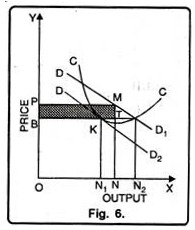ADVERTISEMENTS:
Under monopolistic competition, the word ‘group’ is used for industry. There is a difference between an industry and a group. An industry generally consists of firms which produce homogeneous product, whereas a group is composed of firms which produce a differentiated product. Thus group consists of a number of firms producing close substitutes. For example, shoe making firms like ‘Bata’, ‘Carona’, and ‘Liberty’ are a group.
To study group equilibrium, we assume that:
(i) Demand and cost curves of all the firms are identical,
(ii) No firm can influence the price and output decisions of its rivals.
The Group Equilibrium is shown below with the help of Fig. 5.
In Fig. 6, DD1 is the group demand curve and CC is the cost curve. Every firm would like to fix up OP price because at this price the difference between price and cost is the maximum and producer gets supernormal profit equal to PMTB. The other firms will be attracted to enter the market and now the market demand will be shared by a larger number of firms. In this situation demand curve will shift downwards and the new demand curve will be DD2.
ADVERTISEMENTS:
The number of firms in the market will continue increasing till the new demand curve DD2 is tangent to the cost curve. In the Fig. 6 at point ‘K’ demand curve is tangent to the cost curve. At this point firm will be earning only normal profit and this will be the equilibrium position of the firm. Thus under monopolistic competition, OB is the equilibrium price and ON] is the equilibrium output.
